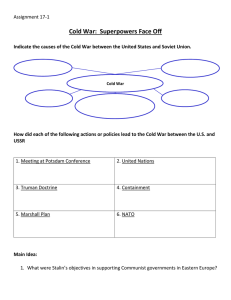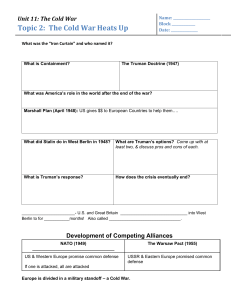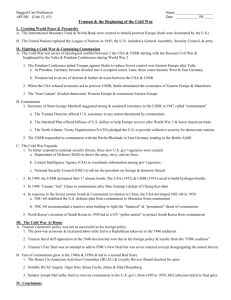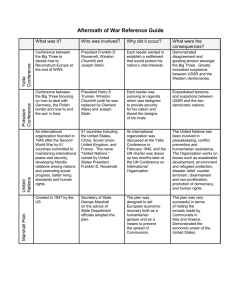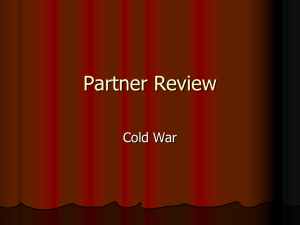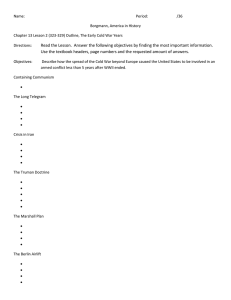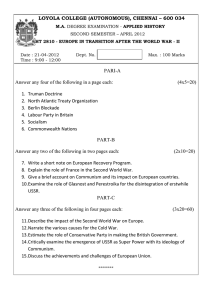The Cold War
advertisement
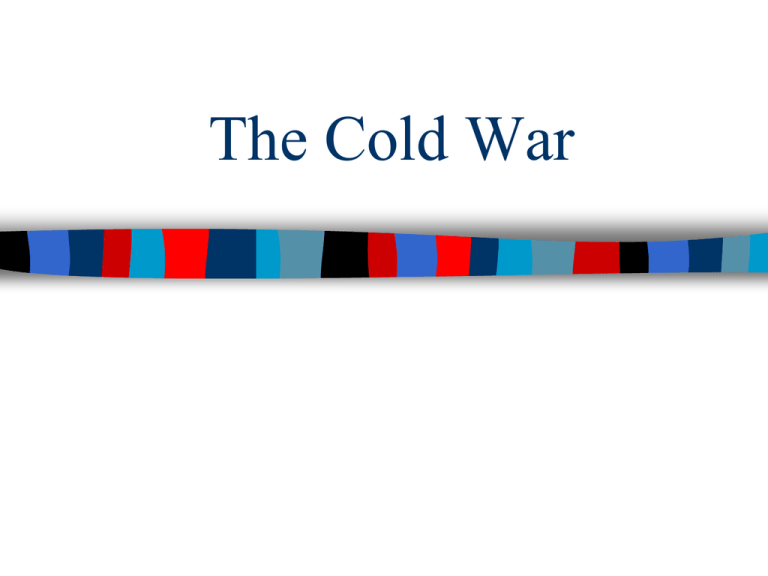
The Cold War U.S. leaders hoped to continue its Creating World Peace & Prosperity trade dominance in Western Europe, Asia, & Latin America ■At the end of WW2, the major The USA was the largest supplier world powers addressed the of funds for both, so the USA had global economy peace-keeping: the greatest control& over policy –To rebuild war-torn Europe, the International Monetary Fund & World Bank were created –The United Nations replaced the League of Nations in 1945 The U.S., U.S.S.R, England, France, & Nationalist China made up the Security Council All 50 member nations were represented on the General Assembly Each member of the Executive Council has veto power over other members An army! The Beginning of the Cold War The USA supported the Russian White Army ■Theagainst Cold Lenin’s War was era of Redan Army distrust, threat of nuclear war, & Stalin agreed to allow self-determination ideological expansion between in Eastern Europe…but never did the superpowers, USA & USSR: – The first inkling of the Cold War began during the Russian Civil War (19171921) & Soviet pullout of WW1 –But, American-Soviet tensions heightened at the Yalta & Potsdam WW2 conferences The Cold War Begins ■In July 1945, Truman first met Stalin at Potsdam to discuss post-war Europe & ending the war with Japan Truman, a rookie, was a “Wilsonian idealist” & hoped for international cooperation Stalin had ruled Russia for 2 decades, was a cautious realist, & believed the USSR needed to protect itself Because Britain, France, the USA, & USSR AtPotsdam Yalta, Stalin agreed to allowof the selfCold War Divisions was the conclusion could determination not agree on German war reparations, in Eastern Europe American-Soviet alliance thatzones at Germany was divided into occupied brought an end World War 2 By Potsdam, hadtoextended his control theStalin Potsdam Conference over Eastern Europe to create a buffer zone between the USSR & its future enemies Potsdam presented a major Cold War theme: Because they could not agree on how do govern Europe, Truman & Stalin divided it The Iron Curtain Capitalism & Democracy Communism & Totalitarianism The USA began to view Stalin in the 1940s as a new Hitler—a dangerous threat & an aggressive dictator desiring world domination Containment ■Truman’s Secretary of State, George Marshall, began a policy of Containment in 1947 –Strong resistance to the USSR would stop Russian expansion “A long-term, patient but firm, and vigilant & the spread of communism containment of Russian expansionist –The U.S. initiated containment policies… Will not lead to any immediate victoryin but3will eventually force the USSR to phases: Truman Plan, live in peace with the West” Marshall Plan, & NATO The Truman Doctrine ■Soviet pressure on Greece & led totoU.S. fears ThisTurkey commitment stopping the of spread of Russian influence continents Communism was viewed byon the3Soviet Union as –Taking an informalGreece declaration of a lead cold war might to communism in Iran & all of Asia –Then, into Egypt & all of Africa –Then, all of Europe through Italy ■The Truman Doctrine offered U.S. assistance to any nation threatened by Communism The Marshall Plan ■European nations had difficulty recovering after WW2 which led to U.S. fears of Communist coups in Europe ■The Marshall Plan offered aid to help Europe recover –Industry revived & Western Europe became a bonanza for U.S. trade & consumer goods –The “Communist threat” ended NATO This is a major departure from the ■Fears of Soviet aggression led to traditional U.S. policy of isolationism the formation of the North Atlantic Treaty Organization in 1949: –To provide collective security for Western Europe, the USA, Canada, Greece, & Turkey –The Cold War now had an ideological (Truman Doctrine) & economic (Marshall Plan) base & military enforcement (NATO) The USSR responded in 1955 with the formation of the Warsaw Pact NATO initiated as a result of a Soviet coup in Czechoslovakia in 1948 The Berlin Blockade ■In 1948, the USSR responded to Containment by cutting off all traffic to Berlin in East Germany –Truman allowed food, fuel, & supplies to be airlifted into West Berlin & moved several U.S. bombers to England –The standoff lasted 2 weeks until Stalin lifted the blockade The Cold War Expands The Military Dimension The new air force was the preferred military ■By of 1947, 3 new wereto agency the Cold War agencies due to its ability created the & military couldattacks better deliver nuclear so bombs deter enemy respond to threats to U.S. security –Dept of Defense to direct the army, navy, & the new air force –Central Intelligence Agency to collect & manage information among all gov’t agencies –Nat’l Security Council to advise the president on nat’l security The The SovietNuclear testing ofArms the atomic bomb Race motivated the USA to regain its advantage; In The American monopoly on nuclear weapons 1952, the U.S. tested the 1st hydrogen bomb technology endedpowerful in 1949 when thea-bomb) USSR (1,000 times more than the successfully tested their own atomic bomb The Soviets responded with their own h-bomb in 1953 The Cold War in Asia ■By 1952, Asia also was divided: The U.S. refused to recognize Communist –After WW2, the U.S. helped China & continued its diplomatic relations a Japanese democracy & with create the Kuomintang Nationalists in Taiwan signed a U.S.-Japanese alliance –In 1949, Truman “lost” China after a Mao Zedong’s defeat of Chiang Kai-shek & Kuomintang –In 1950, China signed a mutual assistance treaty with the USSR Chinese Civil War VS. Nationalist Leader Chiang Kai-shek (Kuomintang) Communist Leader Mao Zedong The Military Dimension ■In 1950, the NSC created a new nat’l defense plan, NSC-68: –Labeled communism a “fanatical” & “permanent” threat NSC-68 came in to political the Soviet NSC-68 military, economic, & towas thea U.S. & response rest of the world development of an atomic bomb && psychological examination of the USSR –Pledged the U.S. tonot only to the “loss” of China communism China in order to develop an appropriate contain communism but to American responses to these threats liberate communist countries policy paper became “blueprint” –Recommended the 3This months after NSC-68 was aexpansion written, its of forU.S. the appeared Cold War & shaped U.S. actions assessment correct when North Korea military, stockpiling nuclear theU.S. nextmilitary 20 years attackedweapons, Southover Korea; buildup began & covert operations The Korean War ■The showdown between the U.S. & USSR in Asia came in Korea: –After WW2, Korea was divided along the 38° with USSR in the North & the USA in the South –Soviet-trained North Korea attacked across the 38° in 1950 –The United Nations condemned North Korea & sent (U.S.) troops Truman was unable to end the Korean War United Nations North Korean Chinese Invasion Counter-Attack Advance JuneOctoberSeptemberSeptember January 1951 October 19501950 Eisenhower made the Korean War a campaign issue in 1952 The Korean War ■MacArthur hoped to unify Korea but Truman feared a world war ■In 1953, the 38° was restored under Eisenhower, but: –Truman achieved his original goal to defend South Korea –The U.S. showed its dedication to fight (not just talk) in the war against the Communists The Cold War at Home The Cold War at Home ■Truman’s policy was The Republicandomestic Congress overturned thenot as successful his foreign Wagner Act with theas Taft-Hartley Act policy that weakened unionsAmericans by forcing members –Post-war found to swear an anti-communist oath prices too high & supply too low on new consumer goods –Union members went on strike to demand their share of wartime company profits –In the 1946 mid-terms, Repubs took back the House & Senate The Cold War at Home ■Reelection 1948 seemed remote He attacked thein“do-nothings” Republicans –Truman facedvoters strong opposition He reminded that the from Republican Dewey, Democrats ended theThomas Depression Progressive Henry Wallace, & The Republicans couldn’t attack Dixiecrat Thurman Truman’s Strom Cold War successes –With nothing to lose, Truman campaigned across the country –The “FDR coalition” of farmers, labor, urban, black voters held together to keep Truman in office Truman and the Fair Deal ■Truman’s Fair Deal tried to extend FDR’s social aid programs: –Called for increasing minimum wage & Social Security benefits –Wanted national heath insurance –Fair Employment Practices Commission to end economic discrimination against blacks ■Repubs & southern Democrats blocked all Fair Deal legislation The Federalists the TheinLoyalty Issue 1790s used the Alien & ■Fear of radicalism is a recurrent Sedition Acts theme in U.S. history; In the The Know-Nothings attacked 1940s &in1950s, American fears of foreigners the 1850s Communism grew as a result of: The Red Scare after WW1 was –The of China to communism aimedfall at radicals & foreigners –The successful testing of an atomic bomb by the USSR –The discovery of American spies –Fear of an unseen conspiracy The Loyalty Issue Alger Hiss in the Dept was accused ■The fear of State Communism abroadof being a USSR spy (the “pumpkin papers”) nd led to a 2 Red Scare in America: –Fears of Soviet espionage led to House Un-American Activities Committee to rid gov’t of spies –Loyalty Review Board fired gov’t Manhattan Project employee Klaus Fuchs fornuclear “reasonable doubt” admitted workers to providing plans to the USSR Dept jailed members Ethel–Justice & Julius Rosenberg were11 executed for the Communist Partydespite for a leakingof atomic secrets to the USSR lack of hard evidence plotting a socialist revolution Used a barrage of treasonable actions McCarthyism in overwhelmed Action against the accused that the defendant’s ability to respond ■In 1950 Joseph McCarthy (R-WI) accused 205 State Dept workers of being Communists; Began a 4½ year attack on “Communists” ■McCarthyism was popular because it offered an easy solution to the Cold War: defeat McCarthy findagencies, a single confirmed He attackedfailed U.S. to gov’t especially the atU.S. home && avoid Communist the gov’t never had theenemy StateinDept, of harboring spiescostly, moreentangling than 50% approval rating among voters policies abroad Conclusions ■Cold War foreign policy dominated American thoughts throughout the 1940s & early 1950s: –Defense spending increased dramatically –The nuclear arms race made people anxious about the future ■With Eisenhower’s election in 1952 American anxieties subsided as the Cold War became more covert
